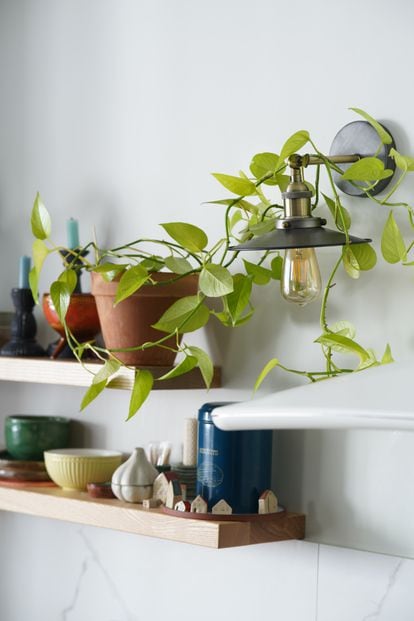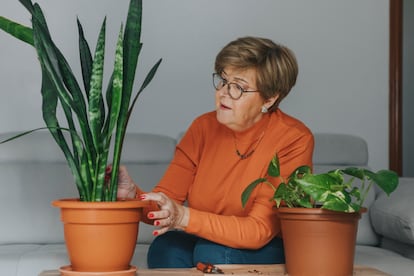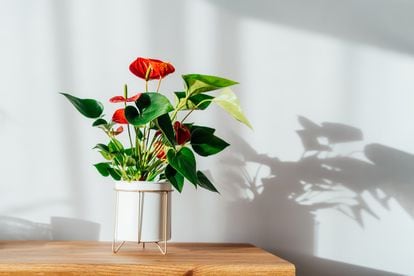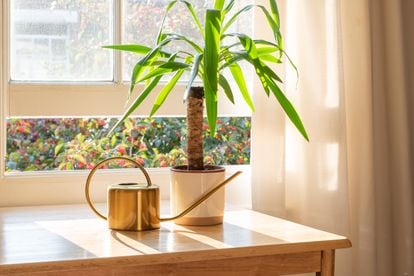In the world, according approximate data, there are about 300,000 species of plants. The number of people who consider themselves plant killer It is still uncounted, but, making a calculation by eye and lacking any scientific rigor, there are many more than they should. And with 300,000 species, it will be bad if there is not one that, with little care and under normal conditions, can survive even in the hands of a matacactus declared.
“More plants die from excess watering than from lack,” says Santiago González, director of the Spanish Association of Garden Centers (AECJ). This is a constant comment among experts and it is that many times we are so afraid of the plant dying that we take excessive care of it and that is precisely what kills it. “The plant with a lack of water will recover, but when it has excess it is impossible,” says Manuel Silvosa, from Silvosa Brothers.
González gives simple advice to avoid this: “Put your finger two or three centimeters into the soil and see if it is dry. If you notice a little moisture, wait a few days to water.” In addition to that, he recommends one transplant per year, especially in March or April, or, alternatively, “you remove a finger of soil from the top and add new substrate. You mix it a little and this gives it many nutrients.” Finally, he advises paying every one or two months. There are countless liquid fertilizers on the market that are mixed with irrigation water. It is important to respect the indicated quantities, again going overboard is more harmful than beneficial.
And once the basic triad for caring for any plant has been clarified, what species should you choose? González launches a warning: “More and more people are seen online selling very special, very rare plants… these mini plants, if you don't know and are a little knowledgeable, they die, they are complicated.” Common sense prevails here. A species native to the Brazilian jungle and accustomed to 85% humidity, is not going to have an easy time in an interior apartment in the center of Madrid. So, after asking the experts, here is a careful selection of perfect plants to remove the sambenito of plant killer.
It is considered one of the most resistant that exists. Its African origin can be seen in the fleshiness of its leaves, which act as water reserves, something that indicates that its water needs are not many. In fact, it is one of the plants that best tolerates drought. “You hardly have to water it and even in summer you can go on vacation for 15 or 20 days without watering it and the plant would live perfectly,” says Silvosa. And as for the light, it adapts well to the amount you have. Of course, it is better to avoid direct sun.
Also called Peace Lily, it is a perennial plant with beautiful white flowers and very few needs. It can be a wonderful plant to improve your gardening skills, because the better we take care of it, the more flowers it will give and above all because, as Silvosa explains, “this plant speaks; When it needs water, it stays with its leaves completely lowered.” Even so, be careful again with overdoing it: when you see the plant a little wilted, you should water it normally, not add excess water. “After a couple of hours it reacts and recovers its natural state,” says Silvosa.

Classic among classics. Here is another plant of tropical origin that has adapted, giving rise to a wonder for first-timers. Like the previous ones, it is only advisable to water Potus or Potho when the substrate is dry because if you water it too much, its leaves begin to show yellow spots. It is a little more demanding in terms of light, but nothing serious, just having indirect light is enough. And the best? “You cut pieces, put them in water and the cuttings come out directly,” says González. With the Potus, you can go from plant killer to give cuttings to friends. There's a reason they were our grandmothers' favorite plants.

“It hardly requires any water, it lasts weeks without watering. Even in winter, from October to March, if you don't want to add even a drop, the plant would not die,” says Silvosa. This is Sansevieria or Tiger's To
ngue, a plant that you can forget about, in fact it is almost the best thing you can do for it. It likes indirect light, but if it doesn't have much, the only thing that will happen is that it will grow more slowly and put out fewer leaves. Furthermore, Sansevieria, like Potus and Spathiphyllum, is a purifying plant, according to a study that NASA did in 1989. In 2015, the BBC confirmed with one of the study's authors that his conclusions were still valid.

For Silvosa it is one of the most resistant flowering plants. If it has good light, always indirect, it will show off with more vivid colors and you can enjoy its flowers for longer. It should be noted that what many believe are flowers of striking red, yellow or white colors are actually leaves that protect the real flower. Like all the previous ones, what could already be considered a mantra is true: do not water until the substrate is dry. If the ambient humidity is low, spraying it with water may be more appreciated than watering it.

Its peculiar appearance and perennial nature make the elephant foot yucca a very decorative option that hardly needs any care. “They are very strong because the entire trunk is a water reserve, so they are watered very little and they work very well,” explains González. As for light, here is a plant that does appreciate direct sun. If it does not have enough light, it will grow more slowly and the color of its leaves may lose some vibrancy, but if it has good light and is transplanted when needed, it can grow quite a bit and become the pride of the house.

#plants #water #stop #39plant #killer39
